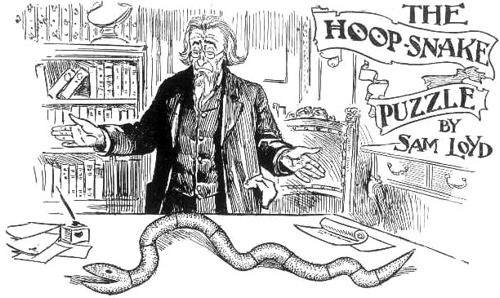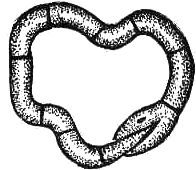



HERE IS AN opportunity for our young puzzlists not only to combine instruction with amusement, but to aid the cause of science. If it were not of serious importance it might be likened to the case which not infrequently happens to puzzlists when they forget the answer to a puzzle they are showing.
Professor Von Schafskopfen, the distinguished naturalist, has been greatly exercised by the conflicting stories concerning the Hoop Snake, which is so called on account of its peculiar mode of locomotion, produced by taking the end of its tail in its mouth and rolling along the ground like a hoop. This trait of the genus ophidia is described by many naturalists, but considerable discussion has been caused by the account given by a college professor who claimed to have seen three snakes, combined in one large hoop, rolling along at lightning speed, and then suddenly disappear by swallowing each other. No one questions the possibility of the swallowing trick, but grave doubts having been thrown upon the existence of the hoop snake. Professor Von Schafskopfen has been scouring the country in search of specimens His labors were so far crowned with success as to discover in the wilds of the Hoop Mountains a fine specimen of a petrified hoop snake, in such a position, with its tail in its mouth, as to prove the truth of the custom. With a fine saw he cut, the snake into ten pieces, and packing them in cotton, returned in triumph with his prize; but has been completely baffled in his attempts to readjust the pieces so as to make both ends meet, and craves your kindly assistance.
Mathematicians say that they can be arranged so as to make 362,882 different snakes, without producing an endless hoop, which the skeptics claim goes to prove that it is 362,882 to 1 that no such snake ever existed.
In his despair the professor asks our puzzlists to submit sketches of the restored Hoop Snake. Puzzles of this nature are offered more in the nature of lessons in puzzle making, for our young folks do not wish to cut up these puzzle pictures. The suggestion is that you might build puzzles upon similar lines.
Professor Von Schafskoppen gratefully acknowledges the valuable assistance of our puzzlists in mastering the difficulties of reconstructing that hoop snake.

2.
In law courts what relation are the judges, sergeants and counselors to each other? They are brothers—brothers-in-law.
Why was St. Paul like a white horse? Because he loves Timothy.
Why do men go out of the theatre? Because some plays are so solemn they must go out to smile.
What is the color of a grass plot covered with snow? Invisible green.
Why don’t foreign noblemen marry poor American girls? A poor girl has no principal, hence no interest, and without either she cannot bank account (a count).
What did the blind man say to the policeman when he told him he would arrest, him if he did not move on? I'd just like to see you.
If Dick's father be John’s son, what relation is Dick to John? His grandson.
When is a silver cup most likely to run? When it's chased.
When may a man's pocket most likely to be empty and yet have something in it? When it has a hole in it.
Why are two t’s like hops? Because they make beer better.
Who are the two largest ladies in the United States? Miss Ouri and Mrs. Sippi (Missouri and Mississippi).
When is butter like Irish children? When it is made into little pats.
What are the most difficult ships to conquer? Hardships.
When are weeds not weeds? When they become widows.
What is better than presence of mind in a railroad accident? Absence of body.
What letter in the alphabet is most useful to a deaf old woman? The letter A, because it makes her hear.
What subject is generally made light of? Gas.
[Page 150]